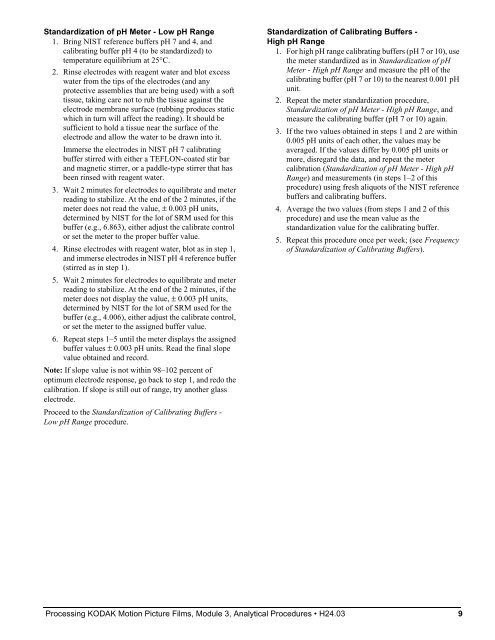Processing kodak motion picture films, module 3 analytical procedures
Processing kodak motion picture films, module 3 analytical procedures
Processing kodak motion picture films, module 3 analytical procedures
Create successful ePaper yourself
Turn your PDF publications into a flip-book with our unique Google optimized e-Paper software.
Standardization of pH Meter - Low pH Range<br />
1. Bring NIST reference buffers pH 7 and 4, and<br />
calibrating buffer pH 4 (to be standardized) to<br />
temperature equilibrium at 25°C.<br />
2. Rinse electrodes with reagent water and blot excess<br />
water from the tips of the electrodes (and any<br />
protective assemblies that are being used) with a soft<br />
tissue, taking care not to rub the tissue against the<br />
electrode membrane surface (rubbing produces static<br />
which in turn will affect the reading). It should be<br />
sufficient to hold a tissue near the surface of the<br />
electrode and allow the water to be drawn into it.<br />
Immerse the electrodes in NIST pH 7 calibrating<br />
buffer stirred with either a TEFLON-coated stir bar<br />
and magnetic stirrer, or a paddle-type stirrer that has<br />
been rinsed with reagent water.<br />
3. Wait 2 minutes for electrodes to equilibrate and meter<br />
reading to stabilize. At the end of the 2 minutes, if the<br />
meter does not read the value, ± 0.003 pH units,<br />
determined by NIST for the lot of SRM used for this<br />
buffer (e.g., 6.863), either adjust the calibrate control<br />
or set the meter to the proper buffer value.<br />
4. Rinse electrodes with reagent water, blot as in step 1,<br />
and immerse electrodes in NIST pH 4 reference buffer<br />
(stirred as in step 1).<br />
5. Wait 2 minutes for electrodes to equilibrate and meter<br />
reading to stabilize. At the end of the 2 minutes, if the<br />
meter does not display the value, ± 0.003 pH units,<br />
determined by NIST for the lot of SRM used for the<br />
buffer (e.g., 4.006), either adjust the calibrate control,<br />
or set the meter to the assigned buffer value.<br />
6. Repeat steps 1–5 until the meter displays the assigned<br />
buffer values ± 0.003 pH units. Read the final slope<br />
value obtained and record.<br />
Note: If slope value is not within 98–102 percent of<br />
optimum electrode response, go back to step 1, and redo the<br />
calibration. If slope is still out of range, try another glass<br />
electrode.<br />
Proceed to the Standardization of Calibrating Buffers -<br />
Low pH Range procedure.<br />
Standardization of Calibrating Buffers -<br />
High pH Range<br />
1. For high pH range calibrating buffers (pH 7 or 10), use<br />
the meter standardized as in Standardization of pH<br />
Meter - High pH Range and measure the pH of the<br />
calibrating buffer (pH 7 or 10) to the nearest 0.001 pH<br />
unit.<br />
2. Repeat the meter standardization procedure,<br />
Standardization of pH Meter - High pH Range, and<br />
measure the calibrating buffer (pH 7 or 10) again.<br />
3. If the two values obtained in steps 1 and 2 are within<br />
0.005 pH units of each other, the values may be<br />
averaged. If the values differ by 0.005 pH units or<br />
more, disregard the data, and repeat the meter<br />
calibration (Standardization of pH Meter - High pH<br />
Range) and measurements (in steps 1–2 of this<br />
procedure) using fresh aliquots of the NIST reference<br />
buffers and calibrating buffers.<br />
4. Average the two values (from steps 1 and 2 of this<br />
procedure) and use the mean value as the<br />
standardization value for the calibrating buffer.<br />
5. Repeat this procedure once per week; (see Frequency<br />
of Standardization of Calibrating Buffers).<br />
<strong>Processing</strong> KODAK Motion Picture Films, Module 3, Analytical Procedures H24.03 9
















